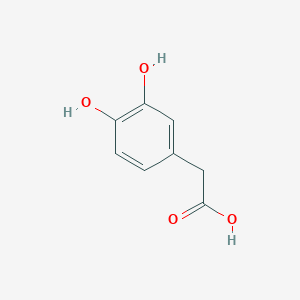Details of Metabolite
| Full List of Protein(s) Regulating This Metabolite | ||||||
|---|---|---|---|---|---|---|
| GPCR glutamate (GPCR-3) | ||||||
| Glutamate receptor mGLU2 (mGluR2) | Click to Show/Hide the Full List of Regulating Pair(s): 1 Pair(s) | |||||
| Detailed Information |
Protein Info
 click to show the details of this protein click to show the details of this protein
|
|||||
| Regulating Pair |
Experim Info
 click to show the details of experiment for validating this pair click to show the details of experiment for validating this pair
|
[1] | ||||
| Introduced Variation | Knockout of Grm2 | |||||
| Induced Change | 3,4-Dihydroxybenzeneacetic acid concentration: decrease (FC = 0.72) | |||||
| Summary | Introduced Variation
|
|||||
| Disease Status | Healthy individual | |||||
| Details | It is reported that knockout of mGlu2/3 leads to the decrease of 3,4-dihydroxybenzeneacetic acid levels compared with control group. | |||||
| Glutamate receptor mGLU3 (mGluR3) | Click to Show/Hide the Full List of Regulating Pair(s): 1 Pair(s) | |||||
| Detailed Information |
Protein Info
 click to show the details of this protein click to show the details of this protein
|
|||||
| Regulating Pair |
Experim Info
 click to show the details of experiment for validating this pair click to show the details of experiment for validating this pair
|
[1] | ||||
| Introduced Variation | Knockout of Grm3 | |||||
| Induced Change | 3,4-Dihydroxybenzeneacetic acid concentration: decrease (FC = 0.72) | |||||
| Summary | Introduced Variation
|
|||||
| Disease Status | Healthy individual | |||||
| Details | It is reported that knockout of mGlu2/3 leads to the decrease of 3,4-dihydroxybenzeneacetic acid levels compared with control group. | |||||
| GPCR rhodopsin (GPCR-1) | ||||||
| Dopamine D4 receptor (D4R) | Click to Show/Hide the Full List of Regulating Pair(s): 1 Pair(s) | |||||
| Detailed Information |
Protein Info
 click to show the details of this protein click to show the details of this protein
|
|||||
| Regulating Pair |
Experim Info
 click to show the details of experiment for validating this pair click to show the details of experiment for validating this pair
|
[2] | ||||
| Introduced Variation | Knockout of Drd4 | |||||
| Induced Change | 3,4-Dihydroxybenzeneacetic acid concentration: decrease (FC = 0.82) | |||||
| Summary | Introduced Variation
|
|||||
| Disease Status | Healthy individual | |||||
| Details | It is reported that knockout of DRD4 leads to the decrease of 3,4-dihydroxybenzeneacetic acid levels compared with control group. | |||||
| Neuropeptide Y (NPY) | ||||||
| Neuropeptide Y (NPY) | Click to Show/Hide the Full List of Regulating Pair(s): 2 Pair(s) | |||||
| Detailed Information |
Protein Info
 click to show the details of this protein click to show the details of this protein
|
|||||
| Regulating Pair (1) |
Experim Info
 click to show the details of experiment for validating this pair click to show the details of experiment for validating this pair
|
[3] | ||||
| Introduced Variation | Antagonist ([D-Trp32]NPY) of Npy | |||||
| Induced Change | 3,4-Dihydroxybenzeneacetic acid concentration: increase (FC = 1.60) | |||||
| Summary | Introduced Variation
|
|||||
| Disease Status | Healthy individual | |||||
| Details | It is reported that Antagonist ([D-Trp32]NPY) of Npy leads to the increase of 3,4-dihydroxybenzeneacetic acid levels compared with control group. | |||||
| Regulating Pair (2) |
Experim Info
 click to show the details of experiment for validating this pair click to show the details of experiment for validating this pair
|
[3] | ||||
| Introduced Variation | Overexpression of Npy | |||||
| Induced Change | 3,4-Dihydroxybenzeneacetic acid concentration: increase (FC = 2.00) | |||||
| Summary | Introduced Variation
|
|||||
| Disease Status | Healthy individual | |||||
| Details | It is reported that overexpression of Npy leads to the increase of 3,4-dihydroxybenzeneacetic acid levels compared with control group. | |||||
| Transcription factor (TF) | ||||||
| R2R3-MYB (AN2) | Click to Show/Hide the Full List of Regulating Pair(s): 1 Pair(s) | |||||
| Detailed Information |
Protein Info
 click to show the details of this protein click to show the details of this protein
|
|||||
| Regulating Pair |
Experim Info
 click to show the details of experiment for validating this pair click to show the details of experiment for validating this pair
|
[4] | ||||
| Introduced Variation | Overexpression of AN2 | |||||
| Induced Change | 3,4-Dihydroxybenzeneacetic acid concentration: increase (FC = 2.04) | |||||
| Summary | Introduced Variation
|
|||||
| Disease Status | Healthy individual | |||||
| Details | It is reported that overexpression of AN2 leads to the increase of 3,4-dihydroxybenzeneacetic acid levels compared with control group. | |||||
If you find any error in data or bug in web service, please kindly report it to Dr. Zhang and Dr. Mou.

